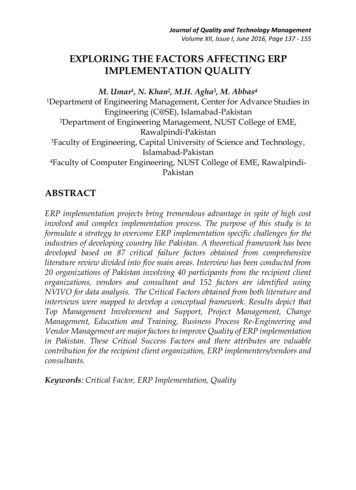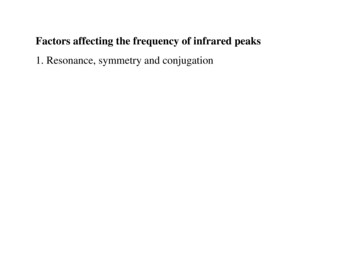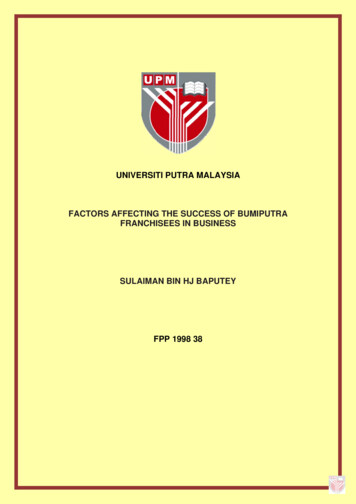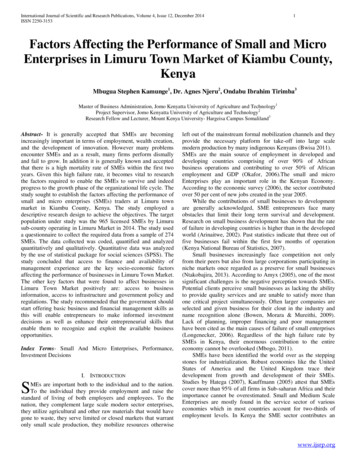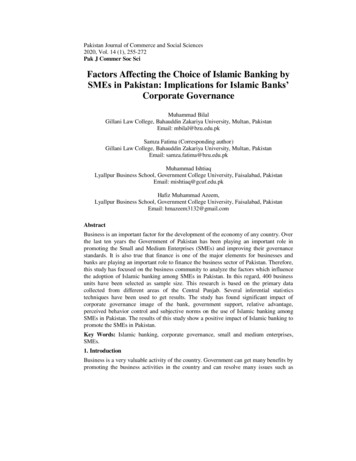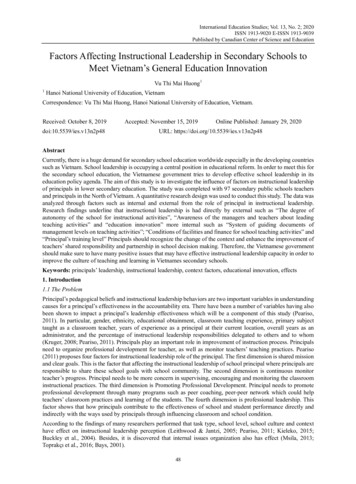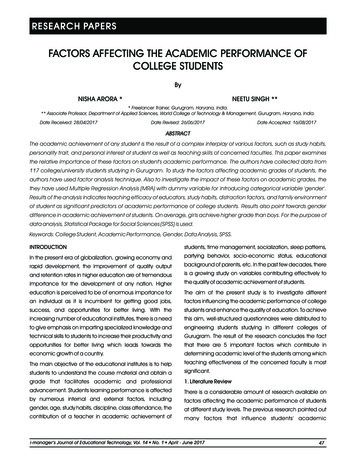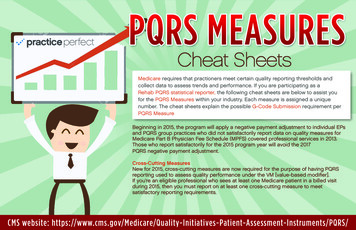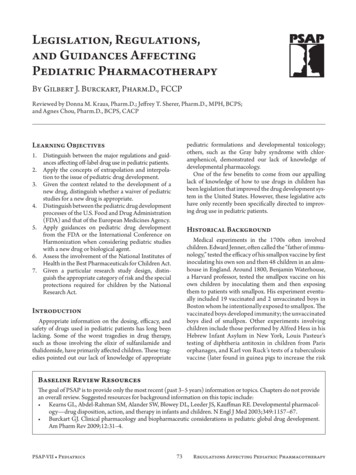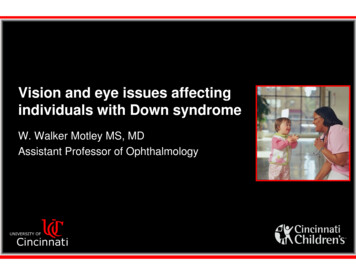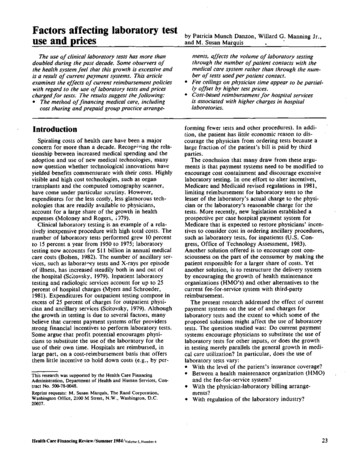
Transcription
Factors affecting laboratory testuse and pricesby Patricia Munch Danzon, Willard G. Manning Jr.,and M. Susan Marquis·The use of clinical laboratory tests has more thandoubled during the past decade. Some observers ofthe health system feel that this growth is excessive andis a result of current payment systems. This articleexamines the effects of current reimbursement policieswith regard to the use of laboratory tests and pricescharged for tests. The results suggest the following: The method offinancing medical care, includingcost sharing and prepaid group practice arrange-ments, affects the volume of laboratory testingthrough the number of patient contacts with themedical care system rather than through the num ber of tests used per patient contact. Fee ceilings on physician time appear to be partial·ly offset by higher test prices. Cost-based reimbursement for hospital servicesis associated with higher charges in hospitallaboratories.Introductionforming fewer tests and other procedures). In addi tion, the patient has little economic reason to dis courage the physician from ordering tests because alarge fraction of the patient's bill is paid by thirdparties.The conclusion that many draw from these argu ments is that payment systems need to be modified toencourage cost containment and discourage excessivelaboratory testing. In one effort to alter incentives,Medicare and Medicaid revised regulations in 1981,limiting reimbursement for laboratory tests to thelesser of the laboratory's actual charge to the physi cian or the laboratory's reasonable charge for thetests. More recently, new legislation established aprospective per case hospital payment system forMedicare that is expected to restore physicians' incen tives to consider cost in ordering ancillary procedures,such as laboratory tests, for inpatients (U.S. Con gress, Office of Technology Assessment, 1983).Another solution offered iS to encourage cost con sciousness on the part of the consumer by making thepatient responsible for a larger share of costs. Yetanother solution, is to restructure the delivery systemby encouraging the growth of health maintenanceorganizations (HMO's) and other alternatives to thecurrent fee-for-service system with third-partyreimbursement.The present research addressed the effect of currentpayment systems on the use of and charges forlaboratory tests and the extent to which some of theproposed solutions might affect the use of laboratorytests. The question studied was: Do current paymentsystems encourage physicians to substitute the use oflaboratory tests for other inputs, or does the growthin testing merely parallels the general growth in medi cal care utilization? ln particular, does the use oflaboratory tests vary: With the level of the patient's insurance coverage? Between a health maintenance organization (HMO)and the fee·for-service system? With the physician-laboratory billing arrange ments? With regulation of the laboratory industry?Spiraling costs of health care have been a majorconcern for more than a decade. Recogr 17ing the rela tionship between increased medical spending and theadoption and use of new medical technologies, manynow question whether technological innovations haveyielded benefits commensurate with their costs. Highlyvisible and high cost technologies, such as organtransplants and the computed tomography scanner,have come under particular scrutiny. However,expenditures for the less costly, less glamorous tech·nologies that are readily available to physicians,account for a large share of the growth in healthexpenses (Moloney and Rogers, ; ')79).Clinical laboratory testing is an example of a rela tively inexpensive procedure with high total costs. Thenumber of laboratory tests performed grew 10 percentto 15 percent a year from 1950 to 1975; laboratorytesting now accounts for 11 billion in annual medicalcare costs (Boisen, 1982). The number of ancillary ser vices, such as laborat.-.ry tests and X-rays per episodeof illness, has increased steadily both in and out ofthe hospital (Sc:tovsky, 1979). Inpatient laboratorytesting and radiologic services account for up to 25percent of hospital charges (Myers and Schroeder,1981). Expenditures for outpatient testing compose inexcess of 25 percent of charges for outpatient physi·dan and ancillary services (Scitovsky, 1979). Althoughthe growth in testing is due to several factors, manybelieve that current payment systems offer providersstrong financial incentives to perform laboratory tests.Some argue that profit potential encourages physi cians to substitute the use of the laboratory for theuse of their own time. Hospitals are reimbursed, inlarge part, on a cost-reimbursement basis that offersthem little incentive to hold down costs (e.g., by perThis research was supported by the Health Care FinancingAdministration, Department of Health and Human Services, Con tract No. 500.78-0048.Reprint requests: M. Susan Marquis, The Rand Corporation,Washington Office, 2100 M Street, N.W., Washington, D.C.20037.Htaflh Care Financing Review/Summer 1984/votume , Numb"'423
Also investigated were the effects of Medicare's previ ous cost-based reimbursement policy on laboratorytest costs and charges,. and the effects of Medicareceilings for office visit fees and room and boardcharges on laborawry test charges.The research was both theoretical and empirical.For the empirical analysis, a number of extant datasources were used, including surveys conducted forthe Department of Health, Education, and Welfare in1975 and 1976 on physician practice costs andincomes (PPCI), data collected by Laboratory Man agement, and Medicare cost data. Data collected aspart of the Rand health insurance experiment (HIE)have also been used. The experiment is a randomizedtrial in health care financing (Newhouse, 1974; New house, et al., 1981). Families in six sites were enrolledin one of a number of experimental insurance plansthat varied in the share of the bill that the family hadto pay for medical expenditures. In one site-Seattle,Washington-some of the experimental participantswere enrolled in an existing HMO, Group HealthCooperative of Puget Sound.The main theoretical and empirical findings aredivided into sections concerning: the use of labora tory tests by fee-for-service office-based physicians;the use of laboratory tests in a health maintenanceorganization; and cost-based reimbursement andhospital laboratory prices. Throughout, results arehighlighted with only brief discussions of the methodsused. Details of the theoretical developments, themethodologies, and the empirical analyses can befound in four technical reports prepared as part of theresearch (Danzon, 1980 and 1982; Marquis, 1982; andManning, 1983).Use of laboratory tests by office-basedphysiciansIssuesOut-of-hospital laboratory tests increased almost 70percent between 1972 and 1977 (Gibson, 1979). Somebelieve this growth is due to the financial incentivesinherent in test ordering. Bailey (1979) argues that theprofit potential in laboratory testing for physicianswho perform tests in-house (i.e., in their own offices)and for those who purchase tests from laboratoriesand then bill their patients for the tests, encouragesthem to overuse tests. Bailey concludes that "movingthe physician out of the financial transaction in test ing-via direct billing laws-is the only workablemeans of discouraging testing based on economic in centives" (Bailey, 1979).The growth of insurance coverage is also cited asa factor in the growth of laboratory tests. Neitherpatients nor physicians, acting on behalf of theirpatients, have an economic incentive to hold down thenumber of tests ordered because a large share of thebill is paid 'by insurance. Although generous insurance24is widely believed to contribute to increased labora tory testing, previous empirical work has not investi gated the effects of the level of the patient's insurancecoverage on the physician's decision about the numberof tests to order for a patient visit.Another concern is that charges for tests by physi cians are excessive relati e to their production cost. Inparticular, are cost savings, brought about by automa tion of many routine tests, captured by physiciansrather than passed on to consumers?Theoretical findingsThe economic model used in this article assumesthat physicians face a demand for visits that dependson the price consumers pay for a visit and the quality(level of care), per visit (Danzon, 1982; Marquis,1982). Physicians are assumed to produce quality bycombining their own time and laboratory tests. Theyare also assumed to choose these quantities (and hencethe quality level) and to set prices for their time andfor tests so as to maximize profits. Insurers, however,may place limits on the charges they allow for timeand tests. Fee schedules limit charges in someinsurance plans; other plans have fee screens based onthe usual, customary, and reasonable charge for theservice.The model predicts that a physician will substitutelaboratory tests for time to produce a unit of qualityif the cost of tests decreases or if third-party allowablecharges are reduced. However, changes in these fac·tors may also affect the level of quality produced, andthe direction of this change is theoretically uncertain.Thus, the theory does not predict how a decrease inthe cost of tests or in third-party allowable chargeswill affect the absolute number of tests per visit or thelength of the visit, although the ratio of tests to timewill increase.For similar reasons, the effect of an increase in thelevel of insurance coverage on the number of testsordered per visit is uncertain. An increase in insurancecoverage reduces the price that consumers pay forhealth care. Total health care consumed is expected toincrease in response to this price decrease, but thedirection of change in quality per visit is ambiguous.When a product has both a quality and quantitydimension, theory does not predict whether theincrease in total consumption of the product will bedue to an increase in quantity, an increase in quality,or both (Willis, 1973). Although total health care con sumed and the total volume of laboratory tests areexpected to increase if insurance coverage increases,the number of tests per visit may rise, fall, or remainunchanged.As noted earlier, there is an increase in the ratio oftests to time resulting from reductions in third-partyallowable charges. However, this prediction holdsonly if there are binding controls on charges for bothtests and time. Third-party payers are believed to beHnltb Care Financing Review/Summer 1984/volumes, Numtter4
more lenient in their review of charges for laboratorytests than for other services because laboratorycharges on any one claim are typically small (Bailey,1979). If reimbursement for tests is not constrained,but there are limits on charges for physician time, thephysician will vary test prices to achieve the optimumtotal price for the visit. (The physician will be able todo so if patients care only about the total charge for avisit and not how charges are divided between ser vices.) That is, a decrease in the allowable charge forphysician time will lead to an offsetting increase in thecharge for tests. The use of tests per visit and visitlength, however, will not be affected. -similarly, aconstraint on fees for tests alone will not affect thenumber of tests or time per visit, but there will be anoffsetting increase in fees for time.Some have suggested that physicians who billpatients directly for tests have an incentive to ordermore tests than physicians who do not bill directly. Asstated earlier, a reduction in the cost of tests leadsphysicians to substitute tests for time to produce eachquality level. Therefore, if laboratories charge higherprices to patients than to physicians, one would expectphysicians who control test. billing to use more testsper visit for a quality level than physicians who donot. If the market is competitive, test use would notbe expected to differ between physicians who controltest billing and those who do not, absent differencesin laboratory price schedules. Bailey (1979) aiguesthat laboratories do use different price schedules forphysicians and patients, and that this results in greateruse of tests by physicians who control test billing.Different price lists do not necessarily mean that lab oratories practice price discrimination, however. Lab oratories argue that the price differences are due tocost differences; significant cost savings may be real ized by billing a doctor for patients treated instead ofbilling each patient for each test.Empirical findingsEffects of patient's insurance coveraaeThe evidence suggests that the patient's insurancecoverage is not an important factor in the number oflaboratory tests ordered during a visit. A summary offindings analyzing data from the I 976 PPCI is givenin Table 1. The numbers in the table are based on alogit regression explaining test frequency; they showhow the probability that the physician orders a testduring an outpatient visit changes if the patient hasinsurance that differs from Blue Shield coverage(Danzon, 1982). 1 The change in probability given achange in insurance varies as the values of the otherexplanatory variables vary. The results in the tableevaluate th.e probability change at one point in thedistribution, namely at the mean values for the otherexplanatory characteristics. The change in probabilityfor a physician with mean characteristics is not the1In addition 10 the insurance coverage indicator variables, otherexplanatory variables include the physician's spedalty, and charac·teristics of the physician's practice and the local lab-oratory indus try.Health C.re Financing Review /Summer 1984/VQiome s, Number same as the mean change over all physicians. Theresults suggest that if the patient is uninsured, theprobability that the physician performs any laboratorytests is 8.7 percentage points lower than if the patienthas Blue Shield coverage. Although this difference isnot statistically significam, it might suggest that physi cians are more likely to order tests as the insurancecoverage of the patient increases. However, the signsand rankings of the results for the other insuranceplans are not consistent with this hypothesis. Medi care, supplemented by private insurance, and Medi caid are the plans in which out-of-pocket costs to thepatient are likely to be lowest. If more generous insur ance induced an increase in tests per visit, physicianswould order more tests fOr patients with Medicaid orsupplemented Medicare than for patients on any otherplan. However, the results show that the probabilityof ordering a test is lower for patients with Medicaidor supplemented Medicare; only for Medicaid patientsis test ordering significantly lower.Tabla 1Effects of patient's Insurance coverage on testfrequency: Physician practice costs andIncomes data resultsPatient's insurance planChange in test frequencyrelative to Blue Shield Plan1PercentNo InsuranceMedicaidMedicare onlySupplemented MedicareOther insurance-8.72-13.9-7.4-9.60.81Estlmated by fitting etoglt equation lor test trequency. The changeestimate I& evaluated at mean of nonplan factors.2Signiflcantly different from zero.SOURCE: Danzon (1982), Table 3.In sum, the PPCI data do not show a consistentrelationship between the patient's out-of-pocket costand the probability that the physician performs a testduring an office visit. In general, differences in test ordering frequency for patients with different levelsof insuranCe coverage are not statistically significant.Because patients on the different insurance plans alsodiffer in other characteristics, a true effect of the levelof insurance coverage on the number of tests orderedper visit may be masked in the PPCI data. Medicaidpatients include a large number of children; Medicarepatients are elderly and disabled. Clinical factors asso ciated with the health problems and needs of thesedifferent groups may dominate any true effect of thelevel of insurance coverage on physician's test ordering behavior. Another factor in these data thatmight offset an effect of generous insurance benefitsis differences in the cost for public and privatecopayors.The HIE data provide a better evaluation of therelationship between the patient's insurance and thenumber of tests ordered per visit. For the HIE study,families were randomly assigned to the experimental25
insurance plans so that the health and sociodemo·graphic characteristics of families on one insuranceplan were like those of families on any other plan.·Except for the level of insurance benefits, reimburse·ment factors did not differ across plans. The HIEdata confirm the conclusion that insurance coverage isnot a significant determinant of the number of testsordered per visit. Estimates from the HIE show howthe probability of a physician's ordering a test duringan outpatient visit changes as the share of the bill thepatient pays (cost sharing) rises from zero (seeTable 2). The results shown in Table 2 are for all out patient visits; results for the probability of orderinga test during a routine examination are presented inTable 3. When specifically controlling for diagnosis,the results are similar to those for all visits; and theprobability of ordering a test neither increases nordecreases consistently as the patient's cost sharingincreases. Further, differences in the probability ofordering tests for patients with varying levels of costsharing were not significant.Table 2Effects of pati8nt's insurance coverage on testfrequency: Outpatient visitsDifference in testfrequency relativeto no cost sharing (free care) 1Patient's cost sharing 2Coinsurance percent255095Adult patientChild patientPercent change0.8-2.56.3-6.0-0.42.0Outpatient services only955.70.01Estimated by fitting a probil equation for test frequency. Thechange estimate is evaluated at the mean of nonplan factors In theregression including the physician's specialty, and other characteris·tics of the physician.2The coinsurance rate applies until the family's out-of-pocket ex·penditure reaches a specified amount that depends on the level offamily Income. The maximum out-of-pocket expenditure faced by anyfamily Is 1000.SOURCE: Marquis (1982), Tables 2 and 3.Table 3Effects of patient's insurance coverage on testfrequency: Routine examinationDifference in testfrequency relativeto no cost sharing (free care) 1Patient's cost sharing 2Coinsurance percent255095Outpatient services only95Adult patientChild patientPercent change0.25.1-8.8-5.6-0.3-2.70.04.01Estimated by fitting a pro bit equation for test frequency. Thechange estimate Is evaluated at mean of nonplan factors In the re gression, including the physician's specialty, and other characteris·lies oltlle physician.2The coinsurance rate applies until the family's out-of-pocket ex·penditure reaches a specified amount that depends on the level offamily income. Tile maximum out-of-pocket expenditure faced by anyfamily Is 1000.SOURCE: Marquis (1982), Tables 2 and 3.26However, one should not conclude from theseresults that physicians' decisions about ordering testsare insensitive to the level of their patients' costsharing. Although the health characteristics ofindividuals assigned to any one plan are the sameas characteristics of individuals on other plans, thehealth characteristics of patients actually seekingcare may not be balanced across plans. Patients withgenerous insurance benefits are more likely to consulta physician (Newhouse eta!. 1981) and, therefore,may be, on average, less sick than patients on otherplans who seek care. Physicians may tend to ordermore tests per visit for patients with generous cover age than for other patients who are equally sick;however, there is no observable effect of insuranceon test ordering frequency because of the greaterhealth needs of patients with less generous insurance.The results show that differen
ing-via direct billing laws-is the only workable means of discouraging testing based on economic in centives" (Bailey, 1979). The growth of insurance coverage is also cited as a factor in the growth of laboratory tests. Neither patients nor physicians, acting on behalf of th
